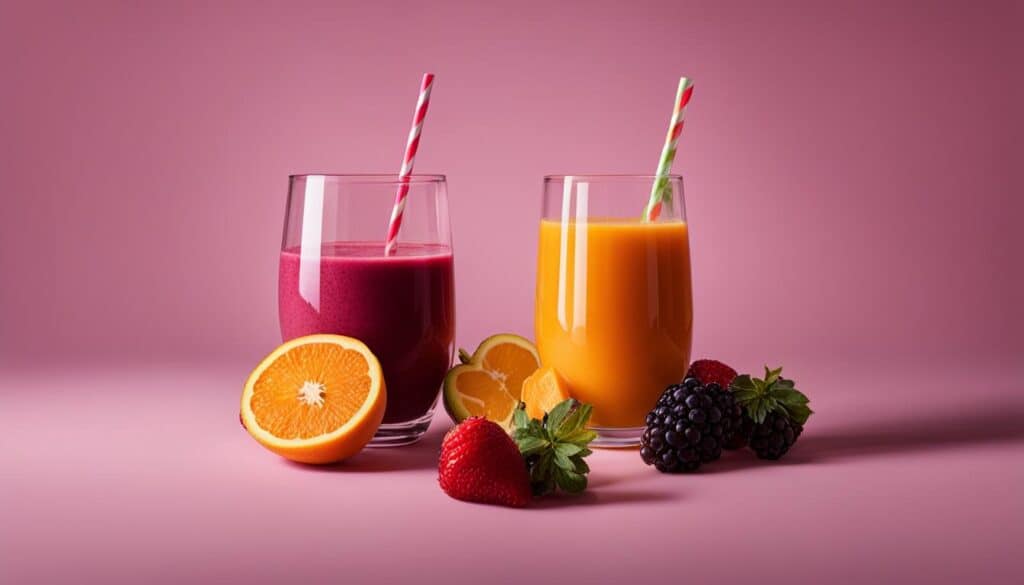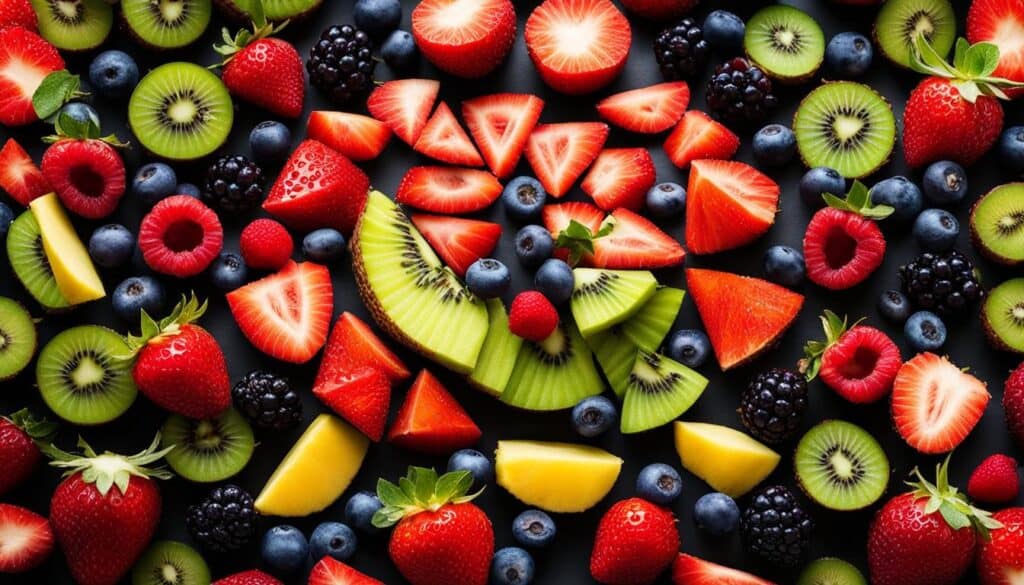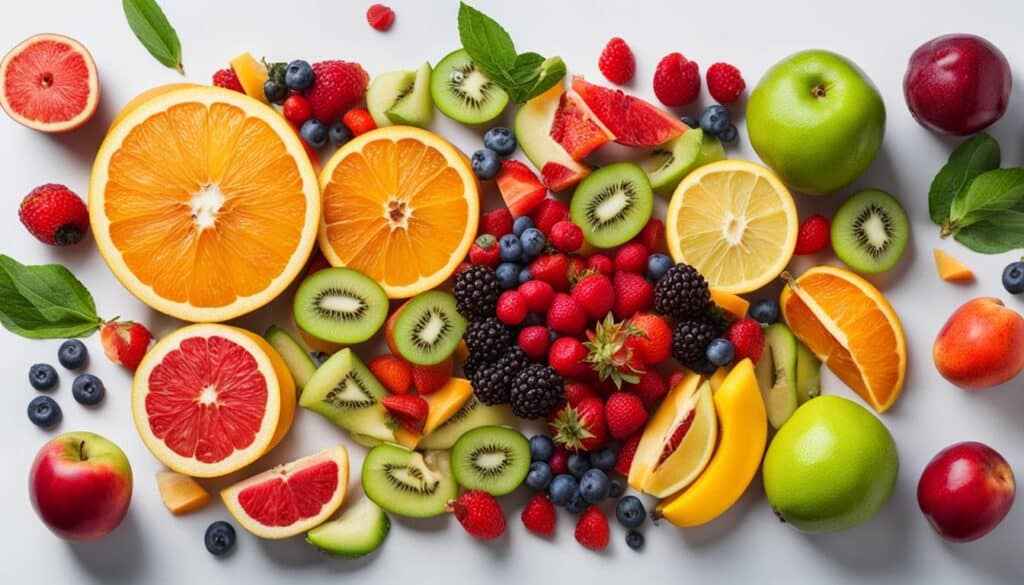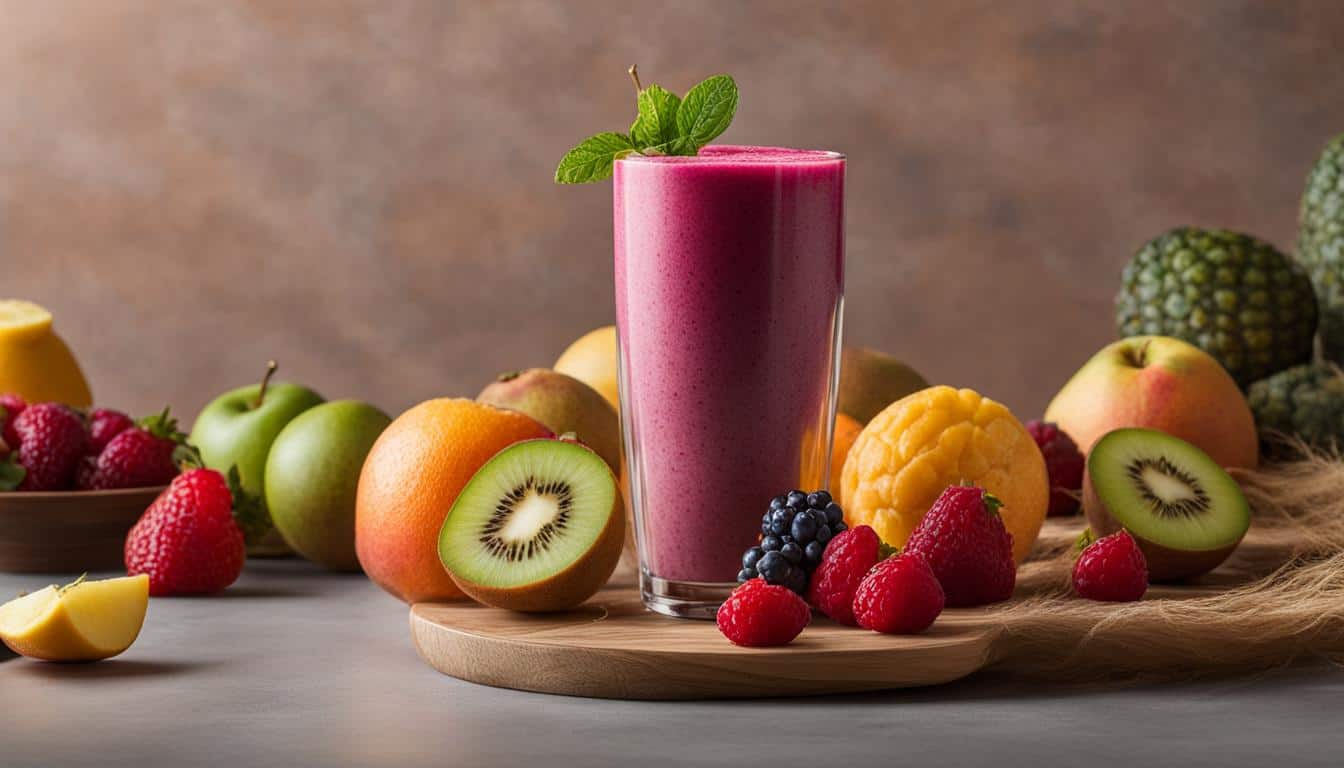Have you ever wondered if your favorite fruit smoothies actually contain fiber? Well, I’m here to uncover the truth for you!
According to multiple sources, blending fruits and vegetables in smoothies does not destroy fiber. In fact, fiber is a type of carbohydrate that passes through the gastrointestinal system intact, providing various health benefits. When you blend fruits and vegetables, you preserve the fiber content, making it easily digestible and ensuring that you reap all the benefits.
So, next time you enjoy a refreshing fruit smoothie, know that you’re not only indulging in a delicious treat but also getting a healthy dose of fiber!
Key Takeaways:
- Blending fruits in smoothies preserves the fiber content and allows for easy digestion.
- Fiber provides various health benefits, including supporting digestive health and promoting regular bowel movements.
- Smoothies are a convenient and delicious way to incorporate fiber into your diet and meet your recommended daily intake.
- Adding high-fiber foods like fruits, vegetables, legumes, whole grains, nuts, and seeds to your smoothies can further increase their fiber content.
- Enjoying a fiber-rich smoothie can help with weight management by increasing feelings of fullness and reducing appetite.
Nutrients and Fiber in Fruit Smoothies
When it comes to incorporating fiber into your diet, fruit smoothies can be a delicious and convenient option. Not only do they provide a refreshing way to enjoy your favorite fruits, but they also retain the fiber content of the blended ingredients. Fiber, a type of carbohydrate, plays a crucial role in supporting digestive health and overall well-being.
In addition to fiber, fruit smoothies are also packed with essential nutrients. Fruits and vegetables are nutrient-dense foods that provide vitamins, minerals, and antioxidants. Blending these ingredients into smoothies helps to preserve the majority of these nutrients, although there may be a small amount of nutrient loss due to oxidation. Adding high-fiber foods like fruits, vegetables, legumes, whole grains, nuts, and seeds to your smoothies can further enhance their nutritional value.
If you’re looking for fiber-rich smoothie recipes, there are plenty of options to choose from. Consider incorporating ingredients like berries, bananas, spinach, chia seeds, and oats into your smoothies to add an extra boost of fiber. You can also experiment with different combinations of fruits and vegetables to create your own nutrient-packed concoctions.
The Benefits of Fiber in Fruit Smoothies
Incorporating fiber into your diet through fruit smoothies offers a range of benefits. Fiber promotes regular bowel movements and helps prevent constipation, supporting a healthy digestive system. It can also help lower cholesterol levels, stabilize blood sugar, and improve cardiovascular health. Consuming fiber-rich smoothies can aid in weight management by increasing feelings of fullness and reducing appetite. Additionally, fiber is important for maintaining a healthy gut microbiome and improving nutrient absorption.
| Benefits of Fiber in Fruit Smoothies | Key Points |
|---|---|
| Improves Digestive Health | Promotes regular bowel movements and prevents constipation. |
| Supports Cardiovascular Health | Helps lower cholesterol levels and stabilize blood sugar. |
| Aids in Weight Management | Increases feelings of fullness and reduces appetite. |
| Enhances Nutrient Absorption | Supports a healthy gut microbiome and improves nutrient absorption. |
By incorporating fiber-rich smoothies into your diet, you can enjoy the numerous benefits of fiber while savoring delicious and nutritious blends of fruits and vegetables.
Blending vs. Juicing for Nutrient Retention

When it comes to preserving essential nutrients, the choice between blending and juicing fruits can significantly impact the nutritional value of your beverage. While both methods have their benefits, blending fruits in smoothies is a better option for retaining essential nutrients compared to juicing.
When you blend fruits, you include the entire fruit, including the skin and pulp, which are rich in various micronutrients. This means that blending preserves not only the fiber content but also a majority of the vitamins, minerals, and antioxidants found in the fruit. The blending process helps to release nutrients from the cell walls, making them more easily absorbed and utilized by the body.
In contrast, juicing involves extracting the liquid from the fruit, leaving behind the fiber-rich pulp. This results in a concentrated liquid that lacks the benefits of fiber and may have a lower overall nutritional value. While juicing can provide a quick and convenient way to consume fruits, it may not be as beneficial for nutrient retention as blending.
By choosing to blend your fruits, you can maximize the retention of essential nutrients and enjoy a beverage that is not only delicious but also packed with a wide range of vitamins, minerals, and antioxidants.
Comparing Blending and Juicing for Nutrient Retention
| Method | Benefits |
|---|---|
| Blending | Preserves fiber, vitamins, minerals, and antioxidants from the entire fruit |
| Juicing | Provides a concentrated liquid but removes fiber and may result in lower overall nutrient content |
As you can see, blending fruits in smoothies is a superior method for retaining essential nutrients compared to juicing. So the next time you reach for your blender, know that you’re making a choice that not only tastes great but also provides you with a nutritious beverage.
The Benefits of Fiber in Fruit Smoothies
Fiber plays a crucial role in promoting digestive health and overall well-being. When it comes to fruit smoothies, incorporating fiber-rich ingredients can offer numerous benefits. Here are some key advantages of consuming fiber in fruit smoothies:
- Fiber for Digestion: Including fiber in your smoothies can help regulate bowel movements and prevent constipation. Fiber adds bulk to the stool and promotes healthy digestion, ensuring the smooth functioning of your gastrointestinal system.
- Fiber for Satiety: The high fiber content in fruit smoothies can help increase feelings of fullness and reduce appetite. By keeping you satisfied for longer periods, fiber can be a valuable tool for those looking to manage their weight or control their calorie intake.
- Fiber for Cardiovascular Health: Consuming fiber-rich smoothies may contribute to improved cardiovascular health. Studies have shown that a high intake of dietary fiber can help lower cholesterol levels and reduce the risk of heart disease.
By incorporating fiber-packed fruits such as berries, apples, pears, and bananas into your smoothies, you can easily boost your fiber intake and enjoy the associated health benefits.
| Fiber-Rich Fruits for Smoothies | Fiber Content per 100g |
|---|---|
| Berries (Raspberries, Blackberries, Blueberries) | 6-9 grams |
| Apple (with skin) | 2.4 grams |
| Pear (with skin) | 3.1 grams |
| Banana | 2.6 grams |
“Including fiber-rich fruits in your smoothies is an easy and delicious way to increase your daily fiber intake and support your digestive health.”
Remember to experiment with different fiber-rich fruits and vegetables to find combinations that suit your taste preferences. Whether you enjoy a refreshing berry smoothie or a green vegetable-packed blend, incorporating fiber in your fruit smoothies can provide a range of health benefits for your body.
Maximizing Fiber and Nutrient Retention in Smoothies
When it comes to maximizing fiber and nutrient retention in smoothies, there are a few key factors to consider. By following these guidelines, you can ensure that your blended fruits and veggies maintain their nutritional value and provide you with the maximum health benefits.
1. Choose Ripe Produce
To ensure that your smoothie is packed with nutrients, it’s important to select ripe produce that is at its peak nutritional value. Ripe fruits and vegetables not only taste better but also contain higher levels of vitamins, minerals, and antioxidants.
2. Consume Immediately
Once you’ve blended your smoothie, it’s best to consume it immediately to preserve the highest nutrient density. Exposure to air and light can cause oxidation, which may lead to some nutrient loss over time. By enjoying your smoothie right away, you can reap the maximum benefits.
3. Store Properly
If you need to store your smoothie for later consumption, it’s important to do so in an airtight container in the refrigerator. This helps to minimize nutrient loss and maintain the freshness of your smoothie. Freezing blended fruits and veggies in portioned containers is also an excellent way to preserve nutrients for longer periods.
By following these simple tips, you can ensure that your smoothies are not only delicious but also packed with fiber and essential nutrients. Incorporating a variety of fruits, vegetables, and high-fiber foods into your smoothie recipes can help you meet your daily nutritional needs and support your overall health and well-being.
Fruits and Their Nutritional Value

When it comes to nutrition, fruits are a powerhouse of essential vitamins, minerals, and antioxidants. Different fruits offer varying combinations of nutrients, making it important to include a variety of fruits in your diet to reap their full benefits.
Vitamins: Fruits are rich in vitamins, which are necessary for various bodily functions. For example, citrus fruits like oranges and strawberries are excellent sources of vitamin C, which supports immune function and collagen production. Bananas, on the other hand, provide a good amount of vitamin B6, important for brain development and function.
Minerals: Fruits are also a great source of minerals that support overall health. For instance, potassium, which plays a crucial role in maintaining healthy blood pressure levels, can be found in bananas, oranges, and avocados. Meanwhile, apples and pears are rich in dietary fiber, aiding in digestion and promoting a healthy gut.
Antioxidants: Antioxidants are compounds that help protect the body against damage from harmful molecules called free radicals. Many fruits, especially berries like blueberries and strawberries, contain high levels of antioxidants. These antioxidants can help reduce inflammation, fight oxidative stress, and potentially decrease the risk of chronic diseases like heart disease and cancer.
To fully benefit from the nutritional value of fruits, it is recommended to consume them in their whole form whenever possible. However, incorporating blended fruits in smoothies can still provide a convenient and delicious way to enjoy their nutrients. Remember to choose a variety of fruits to ensure you’re getting a wide range of essential vitamins, minerals, and antioxidants.
| Fruit | Vitamins | Minerals | Antioxidants |
|---|---|---|---|
| Oranges | Vitamin C | Potassium | Flavonoids |
| Bananas | Vitamin B6 | Potassium | Phenolic compounds |
| Strawberries | Vitamin C | Fiber | Anthocyanins |
| Blueberries | Vitamin C | Fiber | Antioxidants |
Fruit Selection Tips
- Opt for a variety of colorful fruits to ensure a diverse range of nutrients.
- Consider seasonal fruits for maximum freshness and flavor.
- Choose organic fruits when possible to minimize exposure to pesticides.
- Experiment with different textures and flavors to keep your fruit consumption exciting.
Include a mix of fruits in your diet to enjoy a wide array of vitamins, minerals, and antioxidants. By incorporating various fruits into your meals and snacks, you can support your overall health and well-being.
Fruits and Disease Prevention
Fruits have long been recognized for their role in disease prevention. Numerous studies have shown that a high intake of fruits and vegetables is associated with a lower risk of cardiovascular disease, stroke, and type 2 diabetes. Incorporating a variety of fruits into your diet can contribute to better overall health and reduce the risk of chronic diseases.
Fruits are especially beneficial for cardiovascular health. They are rich in vitamins, minerals, and antioxidants, which help protect the heart and blood vessels from damage caused by free radicals. The fiber content in fruits also plays a significant role in promoting heart health by reducing cholesterol levels and improving blood pressure control.
When it comes to diabetes, fruits can be a healthy choice. While fruits do contain natural sugars, they are also packed with fiber, which helps slow down the absorption of sugar into the bloodstream. This can prevent blood sugar spikes and contribute to better glycemic control. It’s important to keep portion sizes in mind and choose whole fruits over fruit juices, which can be higher in sugar and lower in fiber.
For those looking to manage their weight, fruits can be a valuable addition to a balanced diet. They are low in calories, high in water content, and rich in fiber, all of which contribute to feelings of fullness and satiety. Choosing fruits as a snack or incorporating them into meals can help reduce overall calorie intake and support weight loss or weight maintenance goals.
| Cardiovascular Disease | Diabetes | Weight Loss | |
|---|---|---|---|
| Benefits of fruits | Lower risk of cardiovascular disease | Contribute to better glycemic control | Low in calories and high in fiber, promoting satiety |
| Recommended intake | Incorporate a variety of fruits into your diet | Choose whole fruits over fruit juices | Use fruits as a healthy snack or meal addition |
| Considerations | – | Keep portion sizes in mind | – |
Considerations for Fruit Consumption
When it comes to incorporating fruits into your diet, it’s important to consider a few key factors. While fruits are generally healthy and packed with essential nutrients, there are some considerations to keep in mind, especially for individuals with specific dietary needs or health conditions.
Food intolerances to fruits: Some people may have food intolerances or allergies to specific fruits. Common symptoms of food intolerances include gastrointestinal discomfort, skin reactions, and respiratory issues. If you experience any adverse reactions after consuming certain fruits, it’s best to avoid them and consult a healthcare professional for guidance.
Low-carb diets and fruit consumption: For individuals following very low-carbohydrate or ketogenic diets, fruit consumption may need to be limited due to their higher carbohydrate content. These diets typically focus on minimizing carbohydrate intake to induce ketosis. However, it’s important to note that not all fruits are high in carbohydrates, and some can be included in moderation while still adhering to a low-carb eating plan.
Diabetes and fruit consumption: Contrary to popular belief, individuals with diabetes can still enjoy fruits as part of a balanced diet. However, portion control and monitoring overall carbohydrate intake are crucial. It’s advisable to choose fruits with lower glycemic indices and consume them in appropriate quantities to manage blood sugar levels effectively.
| Considerations for Fruit Consumption |
|---|
| Food Intolerances to Fruits |
| Some individuals may have food intolerances or allergies to specific fruits. It’s best to avoid these fruits and consult a healthcare professional if any adverse reactions occur. |
| Low-Carb Diets and Fruit Consumption |
| For those following very low-carbohydrate or ketogenic diets, fruit consumption may need to be limited due to higher carbohydrate content. However, not all fruits are high in carbs, and some can be included in moderation. |
| Diabetes and Fruit Consumption |
| Individuals with diabetes can still enjoy fruits as part of a balanced diet. Portion control and monitoring overall carbohydrate intake are vital for managing blood sugar levels effectively. |
Limitations of Fruit Juices and Dried Fruits

While fruits are generally healthy and provide a range of essential nutrients, it’s important to be mindful of the limitations of fruit juices and dried fruits. These products, although derived from fruits, can have different nutritional profiles and may not offer the same benefits as whole fruits.
Fruit juices, for example, can often contain high amounts of added sugars and lack the natural fiber found in whole fruits. This makes them a less nutritious option compared to consuming whole fruits. It’s important to check the sugar content of fruit juices and opt for those that are 100% fruit juice with no added sugars. However, it’s generally recommended to prioritize whole fruits over fruit juices to maximize fiber intake and overall nutritional value.
On the other hand, dried fruits can be a convenient and portable snack option, but they come with some considerations. Dried fruits are more concentrated in terms of sugar and calorie content compared to their fresh counterparts. This means that it’s easy to consume larger amounts of dried fruits, which can contribute to excess calorie intake if not consumed in moderation.
When choosing dried fruits, it’s important to be mindful of portion sizes and opt for varieties without added sugars or artificial flavors. Additionally, if you have any health conditions like diabetes or are following a specific dietary plan, it’s always best to consult with a healthcare professional or registered dietitian to determine the appropriate portion sizes and frequency of consuming dried fruits.
| Fruit Juices | Dried Fruits |
|---|---|
| Can contain high amounts of added sugars | More concentrated in terms of sugar and calorie content compared to fresh fruits |
| Lack the natural fiber found in whole fruits | Easy to consume larger amounts, which can contribute to excess calorie intake if not consumed in moderation |
| Less nutritious compared to consuming whole fruits | Choose varieties without added sugars or artificial flavors |
Overall, while fruit juices and dried fruits can be enjoyed in moderation, it’s important to prioritize whole fruits in your diet to reap the full nutritional benefits they offer. By consuming a variety of whole fruits, you can ensure a well-rounded intake of essential nutrients and dietary fiber.
The Role of Fruit in Weight Loss

Fruits can play a crucial role in weight loss due to their high fiber and water content, which promotes satiety and helps control calorie intake. Incorporating fruits as a healthy snack option can satisfy cravings for sweets while providing essential nutrients.
Fruits are naturally low in calories and high in fiber, making them a smart choice for weight management. The fiber in fruits adds bulk to the diet, helping you feel full for longer periods and reducing the desire to overeat.
Replacing high-calorie snacks with fresh fruits can be an effective strategy for reducing overall calorie consumption. Fruits are not only low in calories but also provide beneficial vitamins, minerals, and antioxidants that support overall health and well-being.
“Incorporating a variety of fruits into a balanced diet can provide essential nutrients while helping to control portion sizes and satisfy cravings for sweets.”
Including a mix of different fruits in your weight loss journey ensures a diverse range of nutrients and flavors, making your diet more enjoyable. For example, berries are known for their high antioxidant content, while citrus fruits are rich in vitamin C.
Fruit as a Healthy Snack
Choosing fruits as a snack can be a healthier alternative to processed snacks that are often high in added sugars and unhealthy fats. Fruits provide a natural sweetness and can satisfy cravings for something sweet while providing beneficial nutrients.
It’s important to note that portion control is still necessary when consuming fruits, as they do contain natural sugars. However, the fiber in fruits helps slow down the absorption of sugars into the bloodstream, preventing blood sugar spikes and crashes.
By incorporating a variety of fruits into your weight loss plan and focusing on whole, fresh fruits, you can benefit from their satiating properties, nutrient density, and contribution to overall health.
Conclusion
In conclusion, blending fruits in smoothies is a great way to incorporate fiber into your diet. Contrary to popular belief, blending does not destroy fiber but actually preserves it. Fiber is an essential component of a healthy diet, as it promotes digestive health and overall well-being. By including smoothies in your daily routine, you can easily meet your recommended daily intake of fiber.
Fruits are not only rich in fiber but also packed with essential vitamins, minerals, and antioxidants. Whether consumed in their whole form or blended into smoothies, fruits provide numerous health benefits. Incorporating a variety of fruits into your diet can help reduce the risk of cardiovascular disease, support weight management, and provide vital nutrients.
To maintain the highest nutrient density in your smoothies, it is important to use ripe produce that is at its peak nutritional value. Consuming your smoothie immediately after preparation or storing it in an airtight container in the refrigerator can help minimize nutrient loss. Freezing blended fruits and veggies in portioned containers is another way to retain nutrients for longer periods.
Overall, fiber plays a crucial role in a healthy diet. It aids in digestion, helps manage weight, stabilizes blood sugar levels, and supports cardiovascular health. By incorporating a variety of high-fiber foods, including fruits, vegetables, legumes, whole grains, nuts, and seeds, into your smoothies, you can ensure you are meeting your nutritional needs and promoting optimal health.
FAQ
Do fruit smoothies have fiber?
Yes, blending fruits and vegetables in smoothies does not destroy fiber. Fiber is a type of carbohydrate that passes through the gastrointestinal system intact, providing various health benefits.
What are the benefits of fiber in fruit smoothies?
Fiber plays a crucial role in digestion, promoting regular bowel movements, preventing constipation, lowering cholesterol levels, stabilizing blood sugar, supporting cardiovascular health, aiding in weight management, and improving overall gut health and nutrient absorption.
How can I incorporate fiber into my fruit smoothies?
Adding high-fiber foods like fruits, vegetables, legumes, whole grains, nuts, and seeds to your smoothies can increase their fiber content. Using ripe produce, consuming the smoothie immediately after preparation, and storing it in an airtight container in the refrigerator can also help maximize fiber retention.
Is blending or juicing better for nutrient retention?
Blending fruits in smoothies is a better option compared to juicing as it preserves the fiber and a majority of the micronutrients found in the skin and pulp. Blending also helps release nutrients from cell walls and enhances their absorption and utilization in the body.
How can I maximize nutrient retention in my smoothies?
To maximize nutrient retention, use ripe produce at its peak nutritional value. Consume the smoothie immediately after preparation or store it in an airtight container in the refrigerator. Freezing blended fruits and veggies in portioned containers can also help retain nutrients for longer periods.
What nutrients do fruits provide?
Fruits are packed with various nutrients, including vitamins, minerals, and antioxidants. Different fruits contain different combinations of these nutrients, making it beneficial to consume a variety of fruits.
Can fruits help prevent diseases?
Numerous studies have shown that a high intake of fruits is associated with a lower risk of cardiovascular disease, stroke, and type 2 diabetes. Fruits are also beneficial for weight management as they are filling and low in calories.
Are there any considerations for fruit consumption?
Individuals with food intolerances or allergies to specific fruits should avoid consuming them. People following very low-carb or ketogenic diets may also need to limit fruit intake due to its higher carbohydrate content. However, fruits can still be a healthy choice for individuals with diabetes, as long as they are mindful of their portion sizes and overall carbohydrate intake.
Are there any limitations to fruit juices and dried fruits?
Fruit juices often contain high amounts of sugar and lack fiber, making them less nutritious than whole fruits. Dried fruits are concentrated in terms of sugar and calorie content, and it’s easy to consume large amounts of them. It is important to be mindful of portion sizes and choose whole fruits whenever possible.
Can fruit help with weight loss?
Yes, fruits can play a beneficial role in weight loss due to their high fiber and water content, which promotes satiety. Choosing fruits as a healthy snack option can help reduce calorie intake and support weight management goals.
What is the importance of fiber in a healthy diet?
Fiber is an important component of a healthy diet as it promotes digestion, supports bowel regularity, lowers cholesterol levels, stabilizes blood sugar, supports cardiovascular health, aids in weight management, improves gut health, and enhances nutrient absorption.





Leave a Reply